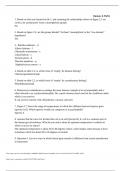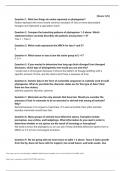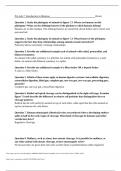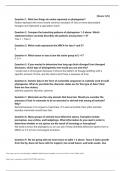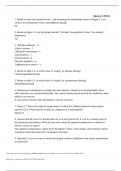Dominican University Of California
Latest uploads at Dominican University Of California. Looking for notes at Dominican University Of California? We have lots of notes, study guides and study notes available for your school.
-
109
- 0
-
8
All courses for Dominican University Of California
Latest notes & summaries Dominican University Of California
6. The glomerular filtrate is described as a: 7. Plasma filtrate containing glucose and protein 8. Protein-free ultrafiltrate of plasma 9. Selective filtrate of plasma containing urea 10. Plasma filtrate without glucose and protein ANS: B DIF: Level 1 OBJ: 3 TOP: Renal physiology 7. Increased production of aldosterone causes: 8. Decreased plasma sodium levels 9. Decreased glomerular blood pressure 10. Increased plasma sodium levels 11. Increased urine volume ANS: C DIF: Level 2 O...
Pre-lab 4: Introduction to Plant Diversity I
Pre-lab 6: Botanical Conservatory and Fungal Diversity (Score: 4.75/5) Question 1. Identify two reasons why maintaining a large, living plant collection is an important public and scientific resource. It lets us study different types of plants without having to travel all over the world and it teaches us better methods of conservation. Question 2. In figure 6.2 above, which season (X or Y) would correspond to winter at point A? Season X Question 3. On which side (left or right) of figure...
Pre-lab 5: Introduction to Plant Diversity II Question 1. In contrast to Bryophytes, Lycophytes, and Monilophytes what specific advantage does pollen provide to seed plants in terms of their reproductive biology? Pollen is advantageous because it does not need water for the male cell to reach the female cell. Instead, pollinators transfer the different cells. Question 2. In contrast to Bryophytes, Lycophytes, and Monilophytes what specific advantage do seeds provide to seed plants in terms...
1. Based on what you learned in lab 1, and assuming the relationships shown in figure 2.1 are correct, do ‘prokaryotes’ form a monophyletic group? No 2. Based on figure 2.2, are the groups labeled “Archaea” monophyletic in the “two-domain” hypothesis? Yes 3. Bacillus anthracis - d Vibrio cholerae - f Chlamydia trachomatis - e Lokiarchaeota - c Yersinia pestis - b Thermus aquaticus - g Staphylococcus aureus - a 4. Based on table 2.2, to which class of ‘trophy’ do hum...
Question 1. What two things do nodes represent on phylogenies? Nodes represent the most recent common ancestor of two or more descendant lineages and represent a speciation event. Question 2. Compare the branching patterns of phylogenies 1-3 above. Which statement below correctly describes the patterns among trees 1-3? Tree 1 = Tree 2 Question 3. Which node represents the MRCA for taxa F and G? 3 Question 4. Which taxon or taxa is/are the sister group to E + F? D, G, H Questi
Pre-Lab 7: Introduction to Metazoa (Score: Question 1. Study the phylogeny of animals in figure 7.3. Where are humans on this phylogeny? What are the defining features of the phylum to which humans belong? Humans are on the chordata. The defining features are notochord, dorsal hollow nerve chord, and post-anal tail. Question 2. Study the phylogeny of animals in figure 7.3. What feature of the phylogeny supports the fact that deep relationships among animals remain unresolved? Polytomy:sho...
Question 1. What two things do nodes represent on phylogenies? Nodes represent the most recent common ancestor of two or more descendant lineages and represent a speciation event. Question 2. Compare the branching patterns of phylogenies 1-3 above. Which statement below correctly describes the patterns among trees 1-3? Tree 1 = Tree 2 Question 3. Which node represents the MRCA for taxa F and G? 3 Question 4. Which taxon or taxa is/are the sister group to E + F? D, G, H Question 5. If
Pre-lab 2 (QUESTIONS AND ANSWERS) University of California, Davis BIS 2C 002C
Pre-lab 5: Introduction to Plant Diversity II Question 1. In contrast to Bryophytes, Lycophytes, and Monilophytes what specific advantage does pollen provide to seed plants in terms of their reproductive biology? Pollen is advantageous because it does not need water for the male cell to reach the female cell. Instead, pollinators transfer the different cells. Question 2. In contrast to Bryophytes, Lycophytes, and Monilophytes what specific advantage do seeds provide to seed plants in terms...





